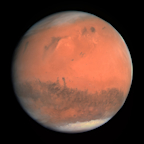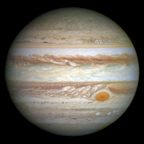Search results
Dark, cold and whipped by supersonic winds, giant Neptune is the eighth and most distant major planet orbiting our Sun. More than 30 times as far from the Sun as Earth, Neptune is not visible to the naked eye. In 2011, Neptune completed its first 165-year orbit since its discovery.
- Neptune: Facts
Neptune is one of two ice giants in the outer solar system...
- Neptune
All About Neptune. Neptune is dark, cold, and very windy....
- Neptune: Facts
Neptune is one of two ice giants in the outer solar system (the other is Uranus). Most (80% or more) of the planet's mass is made up of a hot dense fluid of "icy" materials – water, methane, and ammonia – above a small, rocky core. Of the giant planets, Neptune is the densest.
3 days ago · Neptune, third most massive planet of the solar system and the eighth and outermost planet from the Sun. Because of its great distance from Earth, it cannot be seen with the unaided eye. With a small telescope, it appears as a tiny, faint blue-green disk. It is designated by the symbol ♆.
Dark, cold, and whipped by supersonic winds, ice giant Neptune is the eighth and most distant planet in our solar system. More than 30 times as far from the Sun as Earth, Neptune is the only planet in our solar system not visible to the naked eye. In 2011 Neptune completed its first 165-year orbit since its discovery in 1846.
NEPTUNE is the world's first regional-scale underwater ocean observatory that plugs directly into the Internet. NEPTUNE is the largest installation on the Ocean Networks Canada network of ocean observatories.
- 5.43 km/s
- 0.6713 day, 16 h 6 min 36 s
- 2.68 km/s (9,650 km/h)
May 6, 2024 · All About Neptune. Neptune is dark, cold, and very windy. It's the last of the planets in our solar system. It's more than 30 times as far from the sun as Earth is. Neptune is very similar to Uranus. It's made of a thick fog of water, ammonia, and methane over an Earth-sized solid center.
Diameter: 49,528 kilometers (30,775 miles), Neptune is 3.9 times wider than Earth. Volume: 63 trillion km3 (15 trillion mi3), Earth could fit inside Neptune 63 times. Gravity: 11 m/s², or 1.1 times that of Earth’s. Solar day: 16 Earth hours. Solar year: 60,190 Earth days. Atmosphere: 80% hydrogen, 19% helium, 1% other gases. How we study Neptune.



















